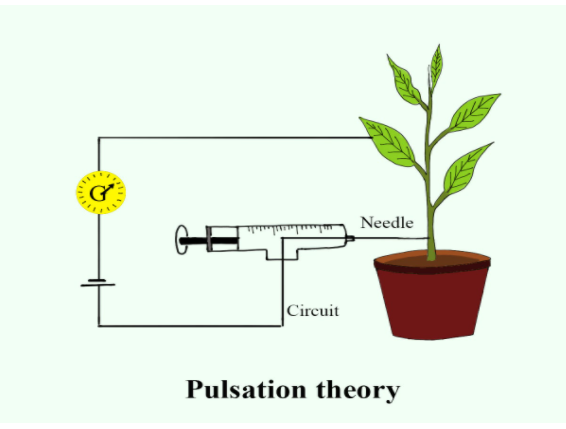
Who proposed the pulsating theory to explain the ascent of sap?
(a) Mc Clung
(b) J.C.Bose
(c) A. Fleming
(d) J. Lederberg
Answer
563.4k+ views
Hint: He is recognized as the best interdisciplinary researcher in India; he was a pioneer of Physics as well as of Plant Biology. Basically, he was the father of Biophysics, sometime before it turned into a field. He was right around 60 years relatively revolutionary in his ideas, examination, and investigation.
Complete answer:
The vital force theory about the ascent of sap was advanced by J.C. Bose (1923). It is known as the pulsation theory. The theory states that the innermost cortical cells of the root absorb water from the external side and pump the same into xylem channels. Although, living cells don’t get involved in the ascent of sap as water continues to rise upward in the plant in which roots have been cut or the living cells of the stem are killed by toxic substances and heat.
Additional Information:
The top four theories of the ascent of sap. The theories are:
1. Vital Force Theory
2. Root Pressure Theory
3. Theory of Capillarity
4. Cohesion Tension Theory.
Root Pressure Theory: This theory was given by Priestley (1916). The root pressure is positive pressure that creates in the xylem sap of the root of some plants. It is an indication of active water absorption.
Theory of Capillarity: Water rises in tubes of small diameter, kept in the vessel having water, due to force of surface tension or adhesion and cohesion. Due to adhesion, water similarly rises up in the walls of xylem channels.
Cohesion Tension Theory (Cohesion-Tension and Transpiration Pull Theory): This theory was given by Dixon and Joly in 1894. It was further improved by Dixon in 1914. Therefore, the theory is also named after him as Dixon’s theory of the ascent of sap.
So, the correct answer is ‘J.C.Bose’.
Note: In order to reach the topmost parts of the plant, the water has to move upward through the stem. Hence, this upward movement of water is called the Ascent of Sap. When the water is absorbed by the roots, it is carried to various parts of the plant. The liquid that moves upward in the stem is not pure water.

Complete answer:
The vital force theory about the ascent of sap was advanced by J.C. Bose (1923). It is known as the pulsation theory. The theory states that the innermost cortical cells of the root absorb water from the external side and pump the same into xylem channels. Although, living cells don’t get involved in the ascent of sap as water continues to rise upward in the plant in which roots have been cut or the living cells of the stem are killed by toxic substances and heat.
Additional Information:
The top four theories of the ascent of sap. The theories are:
1. Vital Force Theory
2. Root Pressure Theory
3. Theory of Capillarity
4. Cohesion Tension Theory.
Root Pressure Theory: This theory was given by Priestley (1916). The root pressure is positive pressure that creates in the xylem sap of the root of some plants. It is an indication of active water absorption.
Theory of Capillarity: Water rises in tubes of small diameter, kept in the vessel having water, due to force of surface tension or adhesion and cohesion. Due to adhesion, water similarly rises up in the walls of xylem channels.
Cohesion Tension Theory (Cohesion-Tension and Transpiration Pull Theory): This theory was given by Dixon and Joly in 1894. It was further improved by Dixon in 1914. Therefore, the theory is also named after him as Dixon’s theory of the ascent of sap.
So, the correct answer is ‘J.C.Bose’.
Note: In order to reach the topmost parts of the plant, the water has to move upward through the stem. Hence, this upward movement of water is called the Ascent of Sap. When the water is absorbed by the roots, it is carried to various parts of the plant. The liquid that moves upward in the stem is not pure water.

Recently Updated Pages
Master Class 11 Economics: Engaging Questions & Answers for Success

Master Class 11 English: Engaging Questions & Answers for Success

Master Class 11 Social Science: Engaging Questions & Answers for Success

Master Class 11 Biology: Engaging Questions & Answers for Success

Class 11 Question and Answer - Your Ultimate Solutions Guide

Master Class 11 Business Studies: Engaging Questions & Answers for Success

Trending doubts
What is meant by exothermic and endothermic reactions class 11 chemistry CBSE

10 examples of friction in our daily life

One Metric ton is equal to kg A 10000 B 1000 C 100 class 11 physics CBSE

Difference Between Prokaryotic Cells and Eukaryotic Cells

What are Quantum numbers Explain the quantum number class 11 chemistry CBSE

1 Quintal is equal to a 110 kg b 10 kg c 100kg d 1000 class 11 physics CBSE




